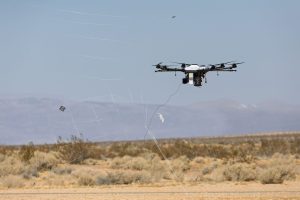Operationalizing AI for Maritime ISR
As artificial intelligence (AI) continues to progress in the defense and autonomy fields, SAIC is positioning itself at the forefront of integrating AI in operational contexts. Jay Meil, the Chief Data Scientist at SAIC, discusses how the company is leveraging AI to enhance maritime intelligence, surveillance, and reconnaissance (ISR), facilitate human-machine collaboration, and manage data processing on a large scale.

Jay Meil leads the AI strategy and solutions at SAIC’s Artificial Intelligence Innovation Factory. Recognized for his contributions to multi-modal data fusion, he has over 18 years of experience in developing mathematical models that enhance data-driven decision-making in defense and national security.
“AI is a buzzword today, but our focus is on automation, machine learning, deep learning, and more advanced concepts like neuro-symbolic AI, generative AI, and agentic AI,” Meil explained. “We aim to merge these technologies to create AI systems that are safer, easier to understand, and more practical for users.”
Over the past four years, SAIC has shifted its focus from experimental AI approaches to operational implementations. “If AI cannot be effectively integrated into tactical operations, it remains merely a theoretical exercise,” Meil noted. “Our AI system must achieve three critical objectives: reduce cognitive workload for operators, enhance the speed of decision-making, and establish human-machine teams that act as force enhancers.”
This approach is significantly impactful in ISR, where operators must oversee extensive areas with limited resources. By utilizing AI for tasks such as pattern detection and object recognition, SAIC allows personnel to concentrate on strategic decisions while the AI manages routine, data-heavy activities.
AI Deployment at the Tactical Edge
SAIC’s method of deploying AI prioritizes integration, transparency, and security. According to Meil, their strategy involves a “best-of-breed” model, where they select and adapt the most effective AI models from reputable sources to fit securely within operational frameworks.
“We don’t create monolithic AI systems from the ground up,” he stated. “Instead, we utilize a robust, validated foundation—whether obtained from open-source or proprietary sources—and customize it to meet specific mission requirements, including implementing security measures and optimizing the model for various deployment conditions.”
A noteworthy advancement for SAIC is the capacity to integrate AI models directly onto maritime platforms. “We can attach AI models to existing sensor systems—even those with lower-resolution cameras—and enable real-time analysis aboard vessels,” Meil explained. This development permits AI to process ISR data onboard instead of depending on cloud computing.
Human-Machine Teaming and AI Explainability
Even though AI excels in processing large datasets, human operators remain the final decision-makers. “We endorse human-machine collaboration where AI manages the routine tasks—recognizing patterns and anomalies—while humans oversee strategic analysis,” Meil explained.
However, the adoption of AI in intelligence and defense encounters a major hurdle: trust. “The primary challenge to AI implementation isn’t technological—it’s human,” Meil stated. “If users don’t understand or trust the AI, its adoption will falter. Thus, we emphasize explainability in our systems.”
SAIC employs techniques like retrieval-augmented generation (RAG) and knowledge-augmented generation (KAG) to ensure that insights produced by AI align with human reasoning. “Our AI systems can explicitly articulate how they reached a conclusion,” Meil added. “For instance, if the AI identifies an ISR target, it doesn’t merely present a confidence score; it guides the operator through its reasoning process, step by step.”
Building a Scalable Data Infrastructure
The success of AI depends heavily on the availability of quality data. Meil observes that the fundamental challenge to AI implementation is not the algorithms but the data structure supporting them.
“To effectively scale AI, we require a foundational data layer that can aggregate, harmonize, label, and curate data from varied sources,” he said. “At SAIC, we are addressing this through initiatives such as the Joint Fires Network (JFN), which aims to unify diverse data streams into a cohesive framework.” JFN represents a U.S. military effort to consolidate and distribute targeting data across multiple domains—including air, land, sea, space, and cyber—using a networked, AI-powered system to enhance battlefield coordination and decision-making. AI is essential to JFN, facilitating real-time data aggregation, automated target recognition, and predictive analytics that enable rapid processing of extensive sensor data, thus improving accuracy in collaborative military operations.
The hybrid data fabric approach adopted by SAIC enables fusion between structured and unstructured data sources, such as ISR feeds, sensor data, and signals intelligence, into a streamlined operational visual. “Our goal is to transition towards a decentralized model where individual platforms—whether unmanned surface vessels or aircraft—can operate autonomously, analyze data at the edge, and subsequently synchronize across a distributed network,” Meil elaborated.
Scaling AI for Maritime ISR and Beyond
SAIC envisions a future where AI-augmented ISR systems can autonomously detect, classify, and track entities across various domains, which is vital for maritime security, particularly in contested and GNSS-denied situations.
“In ISR applications, it’s essential for AI to synthesize reasoning across different sources of intelligence,” Meil remarked. “For example, when we identify a ship, we can link multiple data indicators—its AIS signal, radar signature, visual data, and electronic emissions—to create a comprehensive profile. AI helps integrate this data, allowing operators to make more informed choices.”
Additionally, the company is advancing AI-based ISR capabilities by engineering lightweight models designed for low-energy platforms. “We aim to minimize reliance on extensive cloud infrastructure,” Meil noted. “Instead, we’re committed to developing AI that is smaller, more efficient, and capable of operating on limited-resource platforms like autonomous maritime drones.”
The Future of AI in Autonomy and ISR
Looking forward, SAIC is investigating new AI frameworks that will improve operational resilience. “We are transitioning toward object-based intelligence (OBI), where AI generates persistent, enriched data representations rather than simple detections,” Meil explained. “For instance, when we monitor a ship over time, AI continuously refines its classification with inputs from various sensors. This cumulative approach enhances accuracy and operational effectiveness.”
Furthermore, SAIC is exploring federated learning paradigms that enable various ISR systems—like unmanned underwater vehicles (UUVs) and drones—to share AI training data without relying on centralized cloud systems. This vision allows AI models to advance autonomously even in disconnected scenarios.
Meil believes these innovations will significantly impact the realms of defense, maritime safety, and commercial ISR operations. “The fundamental challenge in AI isn’t the technology—it’s fostering acceptance,” he asserted. “With the right frameworks, transparency, and collaboration between humans and machines, we can elevate AI capabilities to previously unimaginable levels.”
Attribution: Original Article













